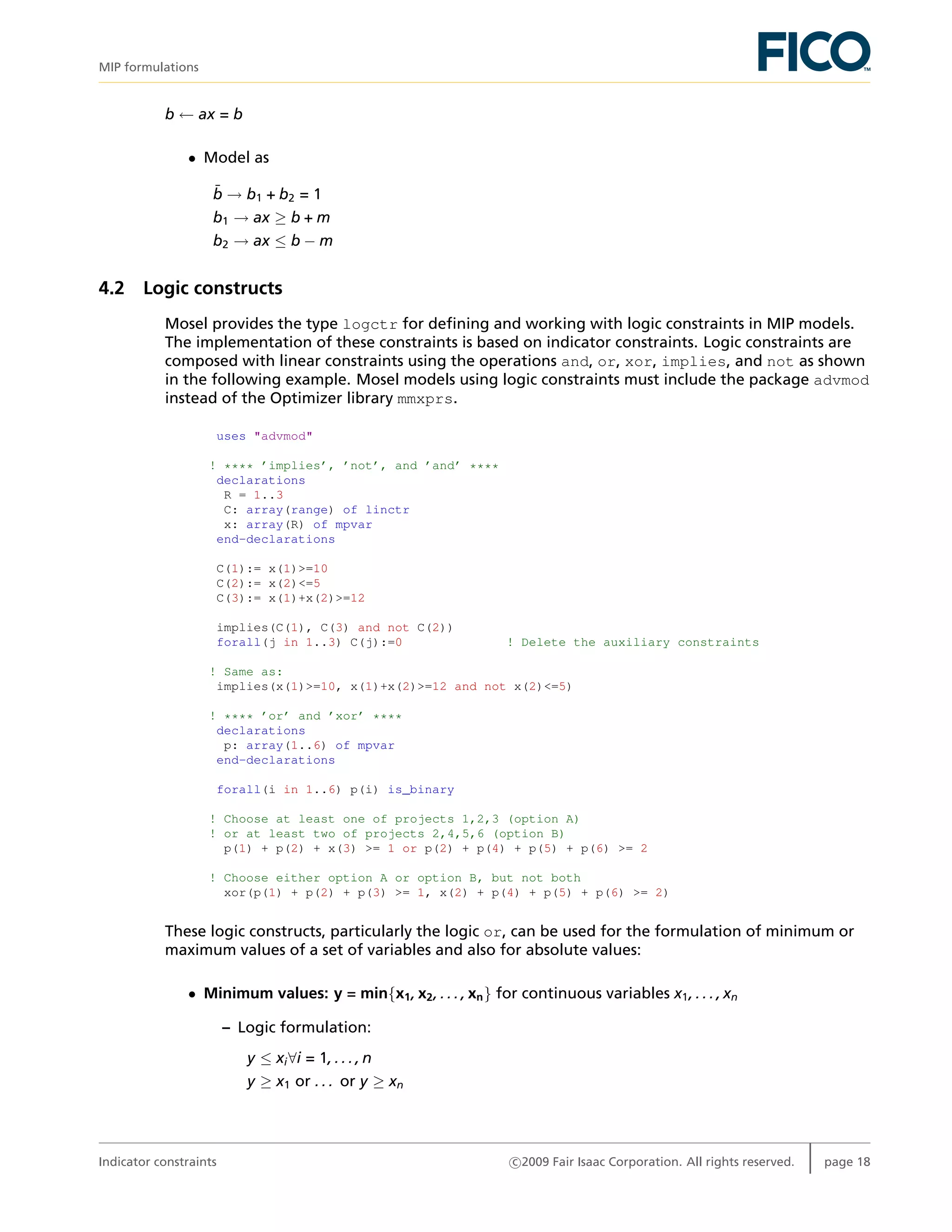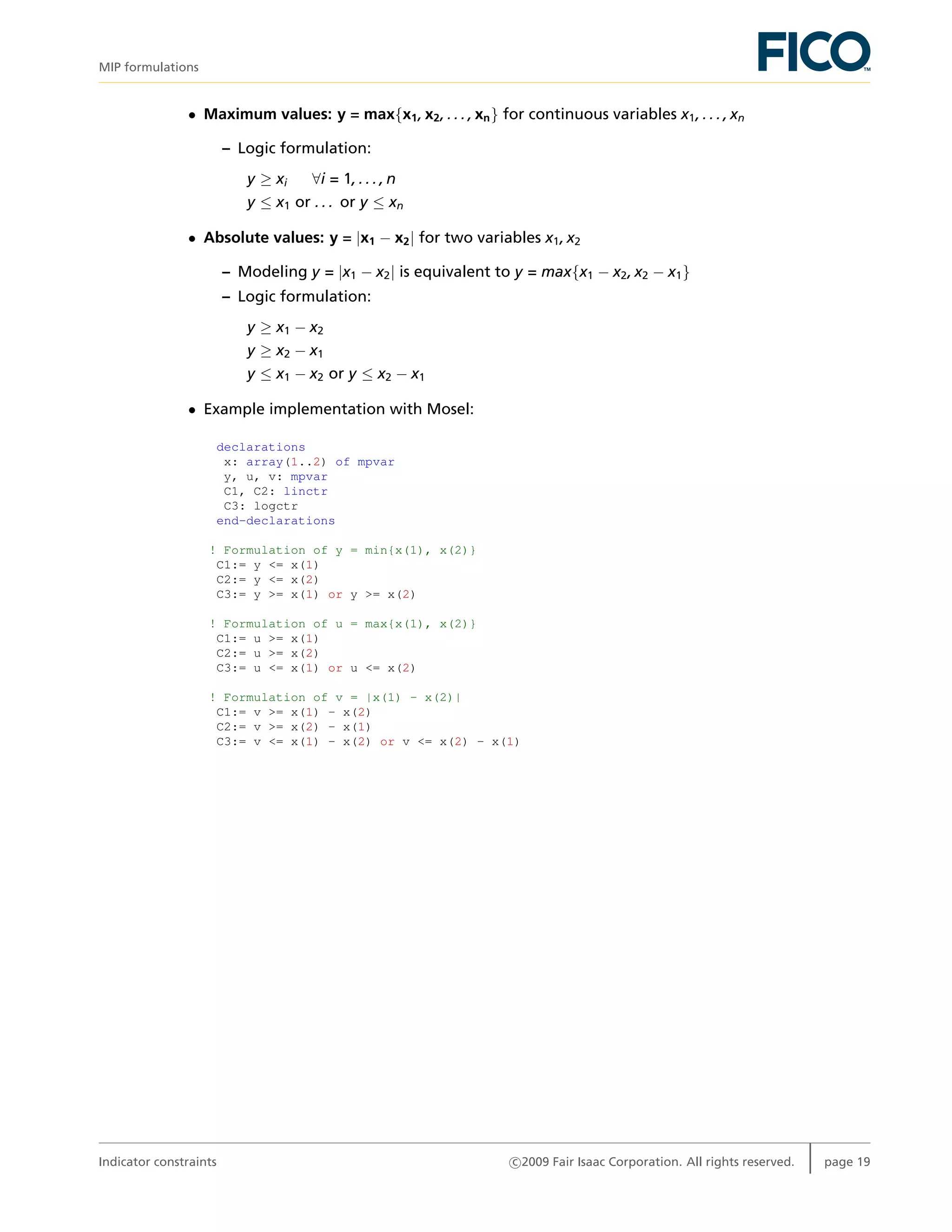This document provides formulations and linearizations for various integer programming constructs that can be used in MIP models in Xpress Optimization Suite, including binary variables, logical conditions, minimum/maximum values, absolute values, logical AND/OR/NOT, products, disjunctions, and more. It also discusses how these constructs can be modeled using entities like semi-continuous variables, special ordered sets, and indicator constraints in Mosel, BCL, and other Xpress interfaces.
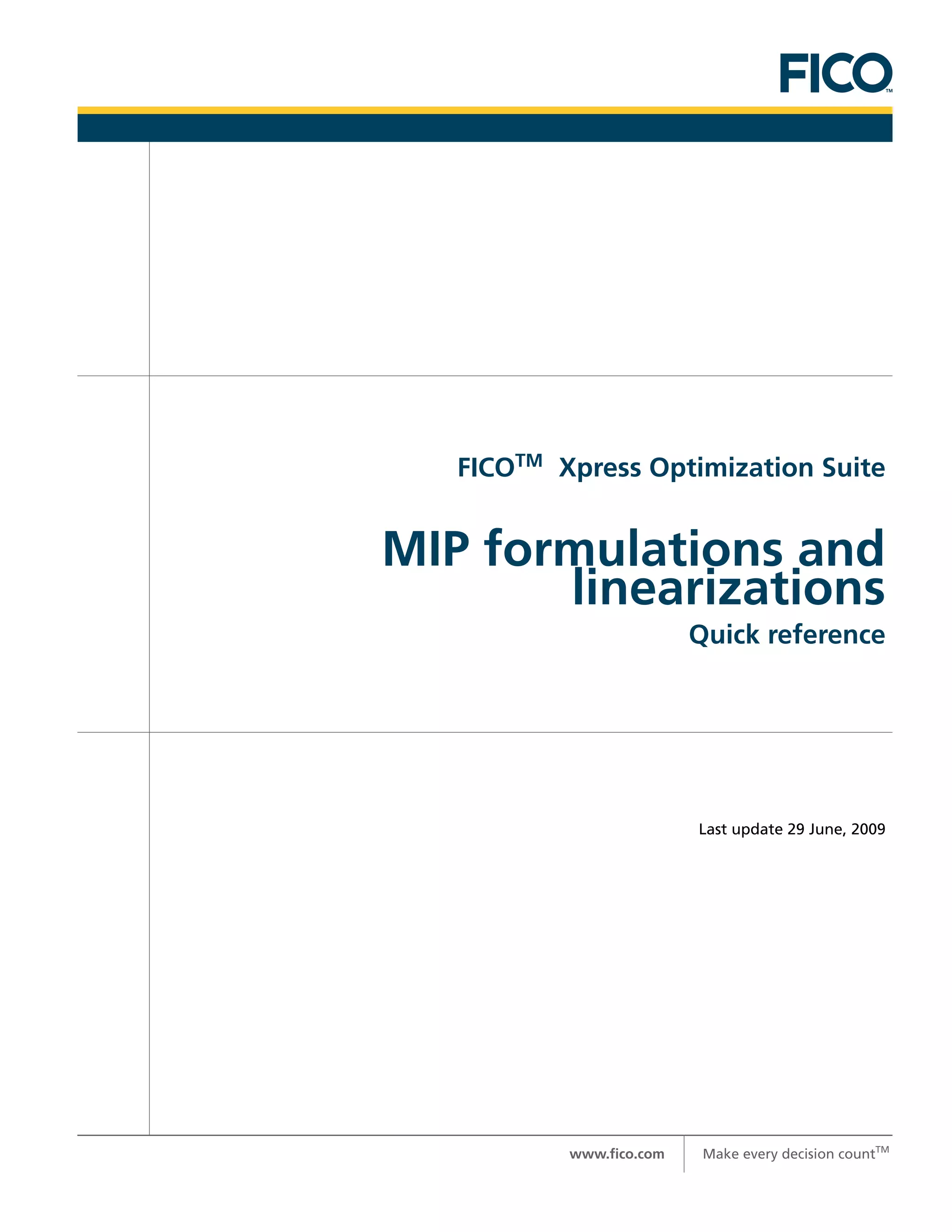
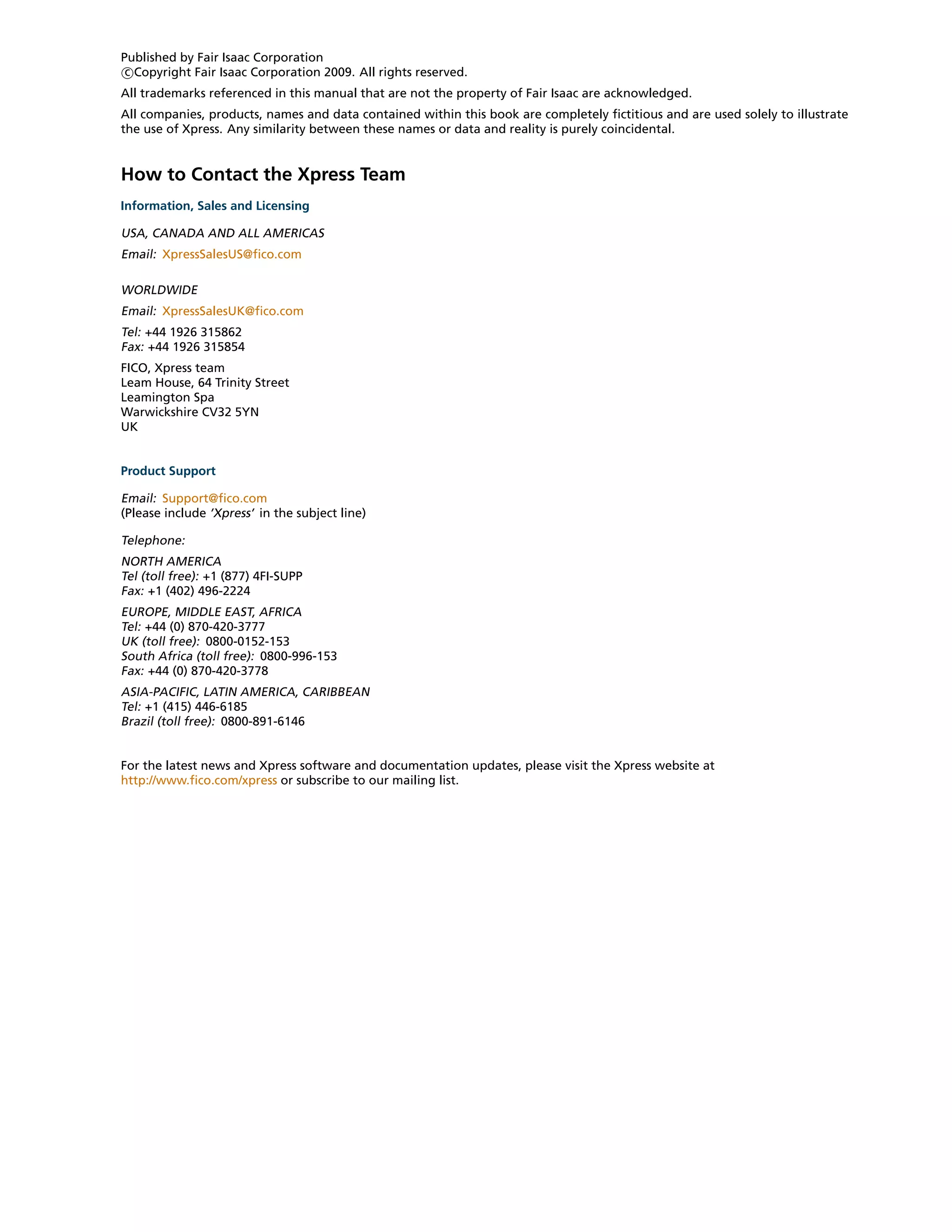
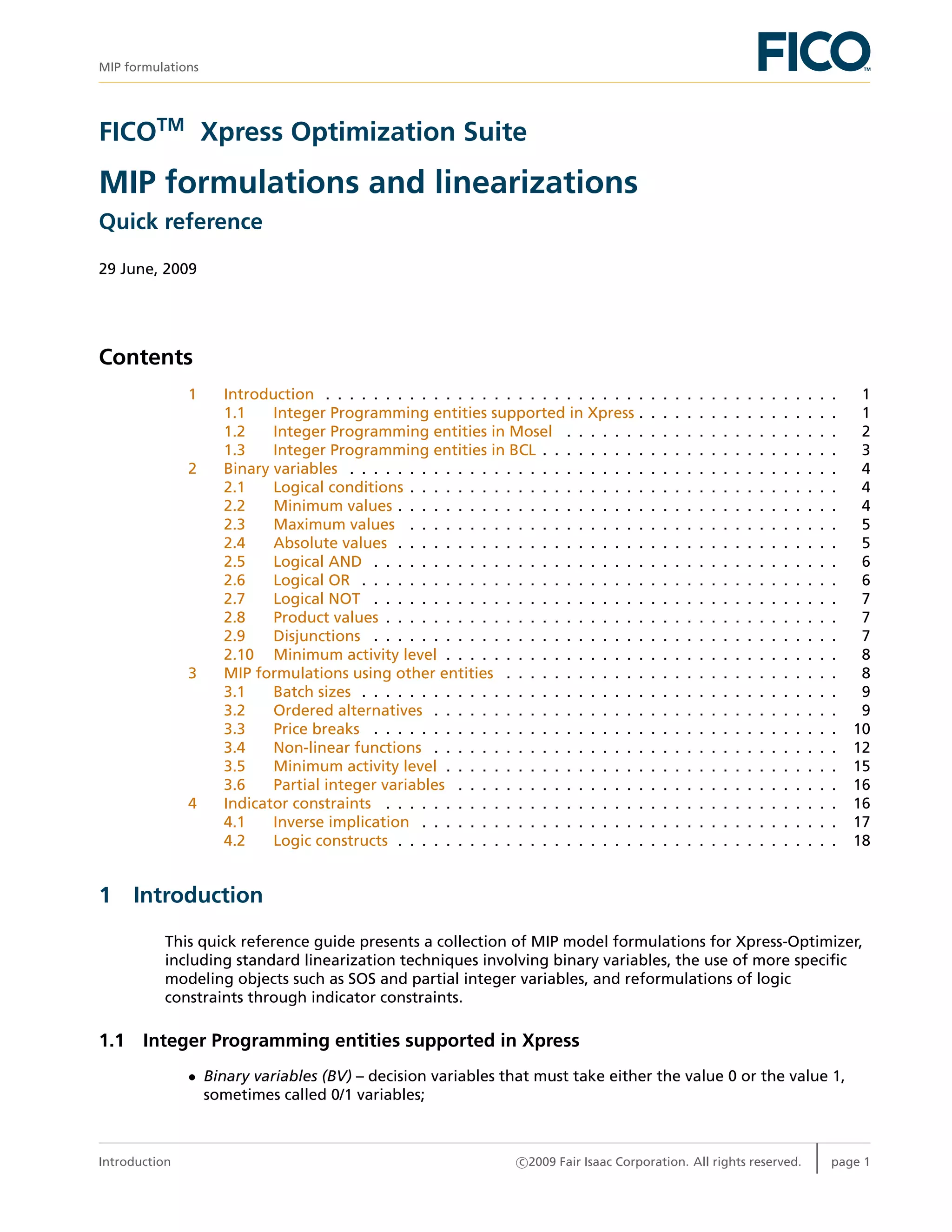
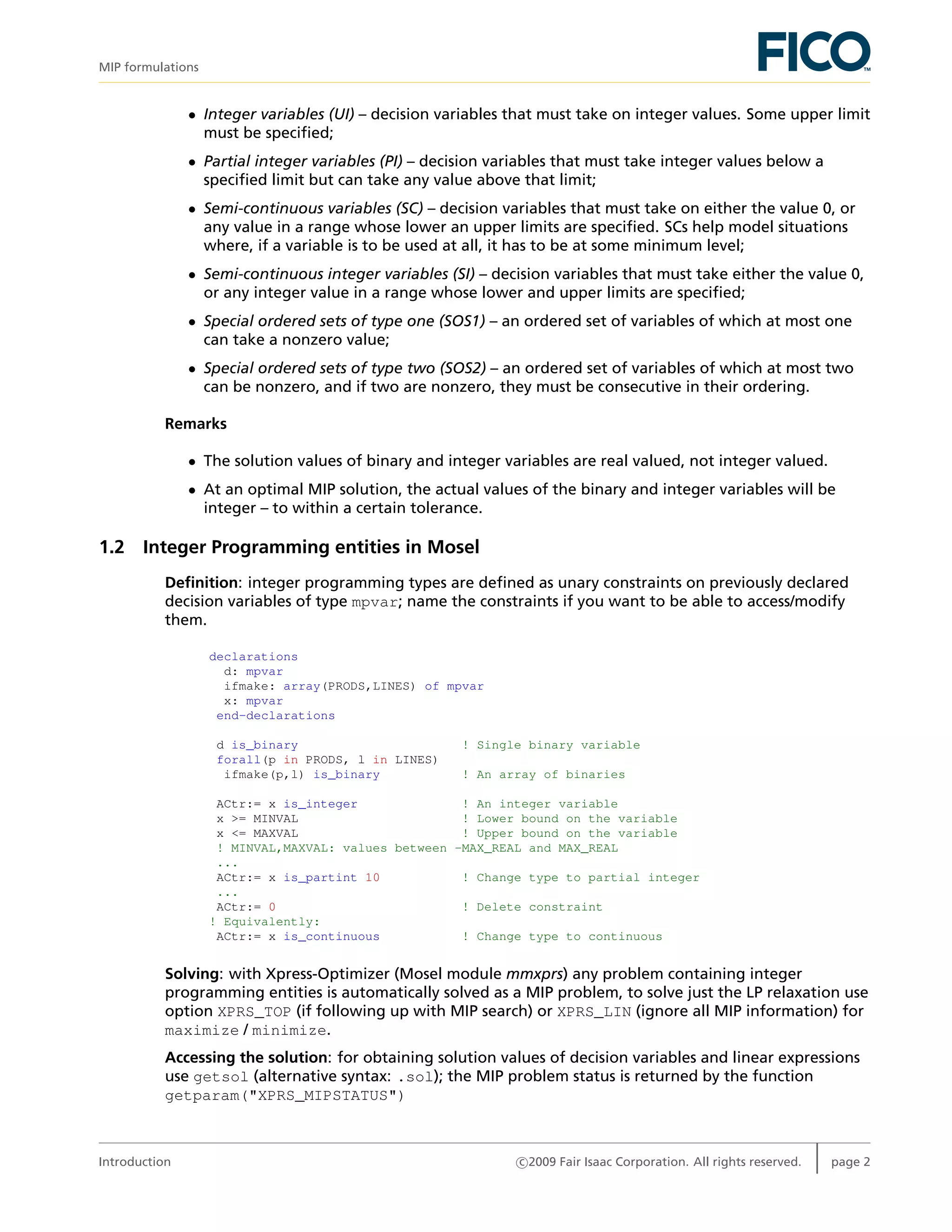
![MIP formulations
case getparam("XPRS_MIPSTATUS") of
XPRS_MIP_NOT_LOADED,
XPRS_MIP_LP_NOT_OPTIMAL: writeln("Solving not started")
XPRS_MIP_LP_OPTIMAL: writeln("LP unbounded or infeasible")
XPRS_MIP_NO_SOL_FOUND,
XPRS_MIP_INFEAS: writeln("MIP search started, no solution")
XPRS_MIP_SOLUTION,
XPRS_MIP_OPTIMAL: writeln("MIP solution: ", , getobjval)
end-case
writeln("x: ", getsol(x))
writeln("d: ", d.sol)
1.3 Integer Programming entities in BCL
The BCL code extracts in this document are formulated for the BCL C++ interface. The other BCL
interfaces (C, Java, C#, VB) work similarly, please refer to the Xpress documentation for further
detail.
Definition: Integer Programming types are specified when creating decision variables (type
XPRBvar); types may be changed with setType.
XPRBprob prob("test");
XPRBvar d, ifmake[NP][NL], x;
int p,l;
d = prob.newVar("d", XPRB_BV); // Single binary variable
for (p = 0; p < NP; p++) // An array of binaries
for (l = 0; l < NL; l++)
ifmake[p][l] = prob.newVar("ifmake", XPRB_BV);
x = prob.newVar("x", XPRB_UI, MINVAL, MAXVAL); // An integer variable
// MINVAL,MAXVAL: reals between -XPRB_INFINITY and XPRB_INFINITY
...
x.setType(XPRB_PI); // Change type to partial integer
x.setLim(10);
...
x.setType(XPRB_PL); // Change type to continuous
Solving: use option "g" in solve / minim / maxim to solve a problem as a MIP problem (per
default only the LP relaxation is solved).
prob.minim("g");
Accessing the solution: for obtaining solution values of decision variables and linear expressions
use getSol; the MIP problem status is returned by getMIPstatus.
int mipstatus = prob.getMIPStat();
switch (mipstatus) {
case XPRB_MIP_NOT_LOADED:
case XPRB_MIP_LP_NOT_OPTIMAL:
cout << "Solving not started" << endl;
break;
case XPRB_MIP_LP_OPTIMAL:
cout << "LP unbounded or infeasible" << endl;
break;
case XPRB_MIP_NO_SOL_FOUND:
case XPRB_MIP_INFEAS:
cout << "MIP search started, no solution" << endl;
break;
case XPRB_MIP_SOLUTION:
Introduction c 2009 Fair Isaac Corporation. All rights reserved. page 3](https://image.slidesharecdn.com/mipformulationsquickreference2-150926212704-lva1-app6892/75/Mip-formulations-quick_reference-2-5-2048.jpg)
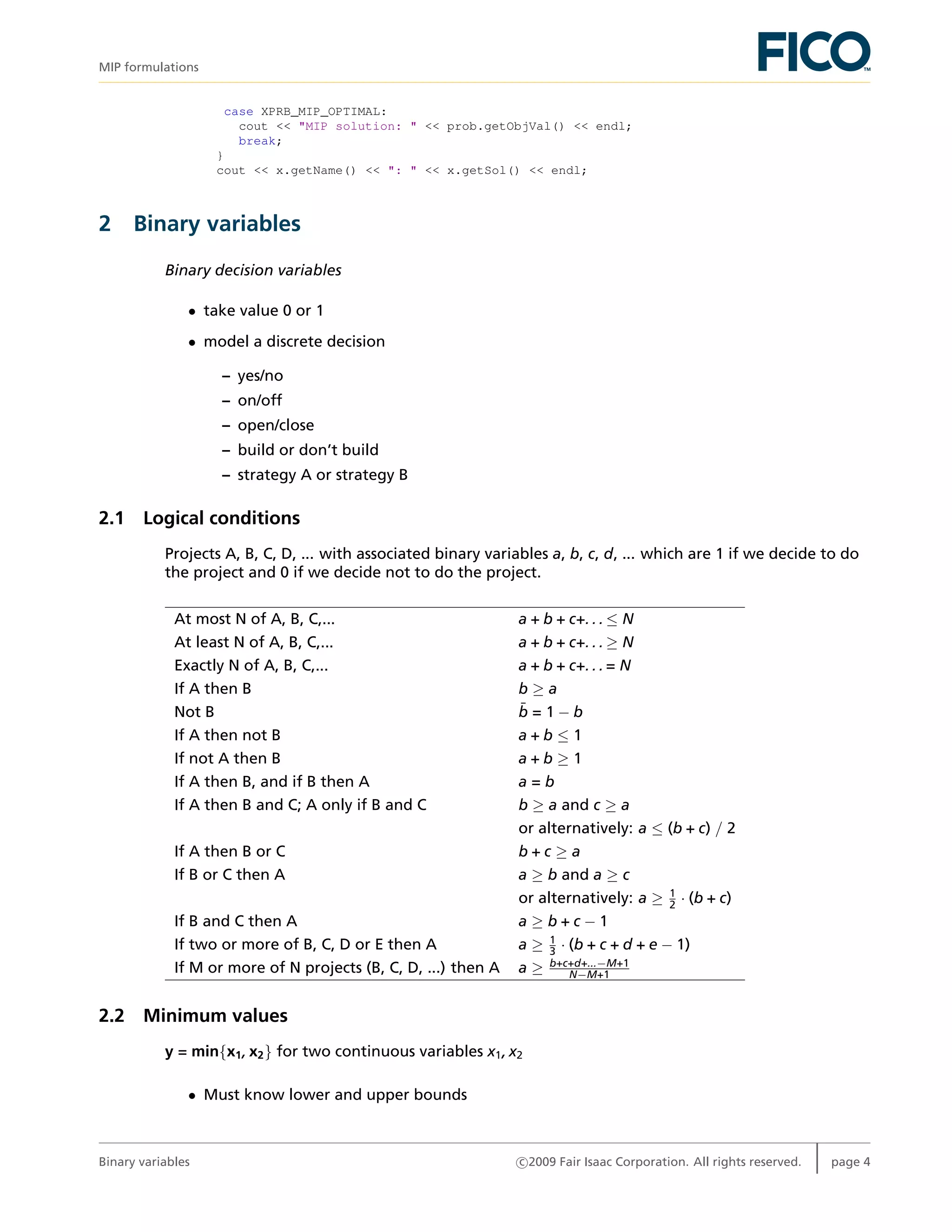
![MIP formulations
L1 ≤ x1 ≤ U1 [1.1]
L2 ≤ x2 ≤ U2 [1.2]
• Introduce binary variables d1, d2 to mean
di 1 if xi is the minimum value;
0 otherwise
• MIP formulation:
y ≤ x1 [2.1]
y ≤ x2 [2.2]
y ≥ x1 − (U1 − Lmin)(1 − d1) [3.1]
y ≥ x2 − (U2 − Lmin)(1 − d2) [3.2]
d1 + d2 = 1 [4]
• Generalization to y = min{x1, x2, . . . , xn}
Li ≤ xi ≤ Ui [1.i]
y ≤ xi [2.i]
y ≥ xi − (Ui − Lmin)(1 − di) [3.i]
i di = 1 [4]
2.3 Maximum values
y = max{x1, x2, . . . , xn} for continuous variables x1, . . . , xn
• Must know lower and upper bounds
Li ≤ xi ≤ Ui [1.i]
• Introduce binary variables d1, . . . , dn
di = 1 if xi is the minimum value, 0 otherwise
• MIP formulation
Li ≤ xi ≤ Ui [1.i]
y ≥ xi [2.i]
y ≤ xi + (Umax − Li)(1 − di) [3.i]
i di = 1 [4]
2.4 Absolute values
y = |x1 − x2| for two variables x1, x2 with 0 ≤ xi ≤ U
• Introduce binary variables d1, d2 to mean
d1 : 1 if x1 − x2 is the positive value
d2 : 1 if x2 − x1 is the positive value
Binary variables c 2009 Fair Isaac Corporation. All rights reserved. page 5](https://image.slidesharecdn.com/mipformulationsquickreference2-150926212704-lva1-app6892/75/Mip-formulations-quick_reference-2-7-2048.jpg)
![MIP formulations
• MIP formulation
0 ≤ xi ≤ U [1.i]
0 ≤ y − (x1 − x2) ≤ 2 · U · d2 [2]
0 ≤ y − (x2 − x1) ≤ 2 · U · d1 [3]
d1 + d2 = 1 [4]
2.5 Logical AND
d = min{d1, d2} for two binary variables d1, d2, or equivalently
d = d1 · d2 (see Section 2.8), or
d = d1 AND d2 as a logical expression
• IP formulation
d ≤ d1 [1.1]
d ≤ d2 [1.2]
d ≥ d1 + d2 − 1 [2]
d ≥ 0 [3]
• Generalization to d = min{d1, d2, . . . , dn}
d ≤ di [1.i]
d ≥ i di − (n − 1) [2]
d ≥ 0 [3]
Note: equivalent to d = d1 · d2·. . . ·dn
and (as a logical expression): d = d1 AND d2 AND ... AND dn
2.6 Logical OR
d = max{d1, d2} for two binary variables d1, d2, or
d = d1 OR d2 as a logical expression
• IP formulation
d ≥ d1 [1.1]
d ≥ d2 [1.2]
d ≤ d1 + d2 [2]
d ≤ 1 [3]
• Generalization to d = max{d1, d2, . . . , dn}
d ≥ di [1.i]
d ≤ i di [2.i]
d ≤ 1 [3]
Note: equivalent to d = d1 OR d2. . . OR dn
Binary variables c 2009 Fair Isaac Corporation. All rights reserved. page 6](https://image.slidesharecdn.com/mipformulationsquickreference2-150926212704-lva1-app6892/75/Mip-formulations-quick_reference-2-8-2048.jpg)
![MIP formulations
2.7 Logical NOT
d = NOT d1 for one binary variable d1
• IP formulation
d = 1 − d1
2.8 Product values
y = x · d for one continuous variable x, one binary variable d
• Must know lower and upper bounds
L ≤ x ≤ U
• MIP formulation:
Ld ≤ y ≤ Ud [1]
L(1 − d) ≤ x − y ≤ U(1 − d) [2]
Product of two binaries: d3 = d1 · d2
• MIP formulation:
d3 ≤ d1
d3 ≤ d2
d3 ≥ d1 + d2 − 1
2.9 Disjunctions
Either 5 ≤ x ≤ 10 or 80 ≤ x ≤ 100
• Introduce a new binary variable:
ifupper: 0 if 5 ≤ x ≤ 10; 1 if 80 ≤ x ≤ 100
• MIP formulation:
x ≤ 10 + (100 − 10) · ifupper [1]
x ≥ 5 + (80 − 5) · ifupper [2]
• Generalization to Either L1 ≤ i Aixi ≤ U1 or L2 ≤ i Aixi ≤ U2 (with U1 ≤ L2)
i Aixi ≤ U1 + (U2 − U1) · ifupper [1]
i Aixi ≥ L1 + (L2 − L1) · ifupper [2]
Binary variables c 2009 Fair Isaac Corporation. All rights reserved. page 7](https://image.slidesharecdn.com/mipformulationsquickreference2-150926212704-lva1-app6892/75/Mip-formulations-quick_reference-2-9-2048.jpg)
![MIP formulations
2.10 Minimum activity level
Continuous production rate make that may be 0 (the plant is not operating) or between allowed
production limits MAKEMIN and MAKEMAX
• Introduce a binary variable ifmake to mean
ifmake : 0 if plant is shut
1 plant is open
MIP formulation:
make ≥ MAKEMIN · ifmake [1]
make ≤ MAKEMAX · ifmake [2]
Note: see Section 3.5 for an alternative formulation using semi-continuous variables
• The ifmake binary variable also allows us to model fixed costs
– FCOST: fixed production cost
– VCOST: variable production cost
MIP formulation:
cost = FCOST · ifmake + VCOST · make [3]
make ≥ MAKEMIN · ifmake [1]
make ≤ MAKEMAX · ifmake [2]
3 MIP formulations using other entities
In principle, all you need in building MIP models are continuous variables and binary variables.
But it is convenient to extend the set of modeling entities to embrace objects that frequently
occur in practice.
Integer decision variables
• values 0, 1, 2, ... up to small upper bound
• model discrete quantities
• try to use partial integer variables instead of integer variables with a very large upper bound
Semi-continuous variable
• may be zero, or any value between the intermediate bound and the upper bound
• Semi-continuous integer variables also available: may be zero, or any integer value between
the intermediate bound and the upper bound
Special ordered sets
• set of decision variables
MIP formulations using other entities c 2009 Fair Isaac Corporation. All rights reserved. page 8](https://image.slidesharecdn.com/mipformulationsquickreference2-150926212704-lva1-app6892/75/Mip-formulations-quick_reference-2-10-2048.jpg)
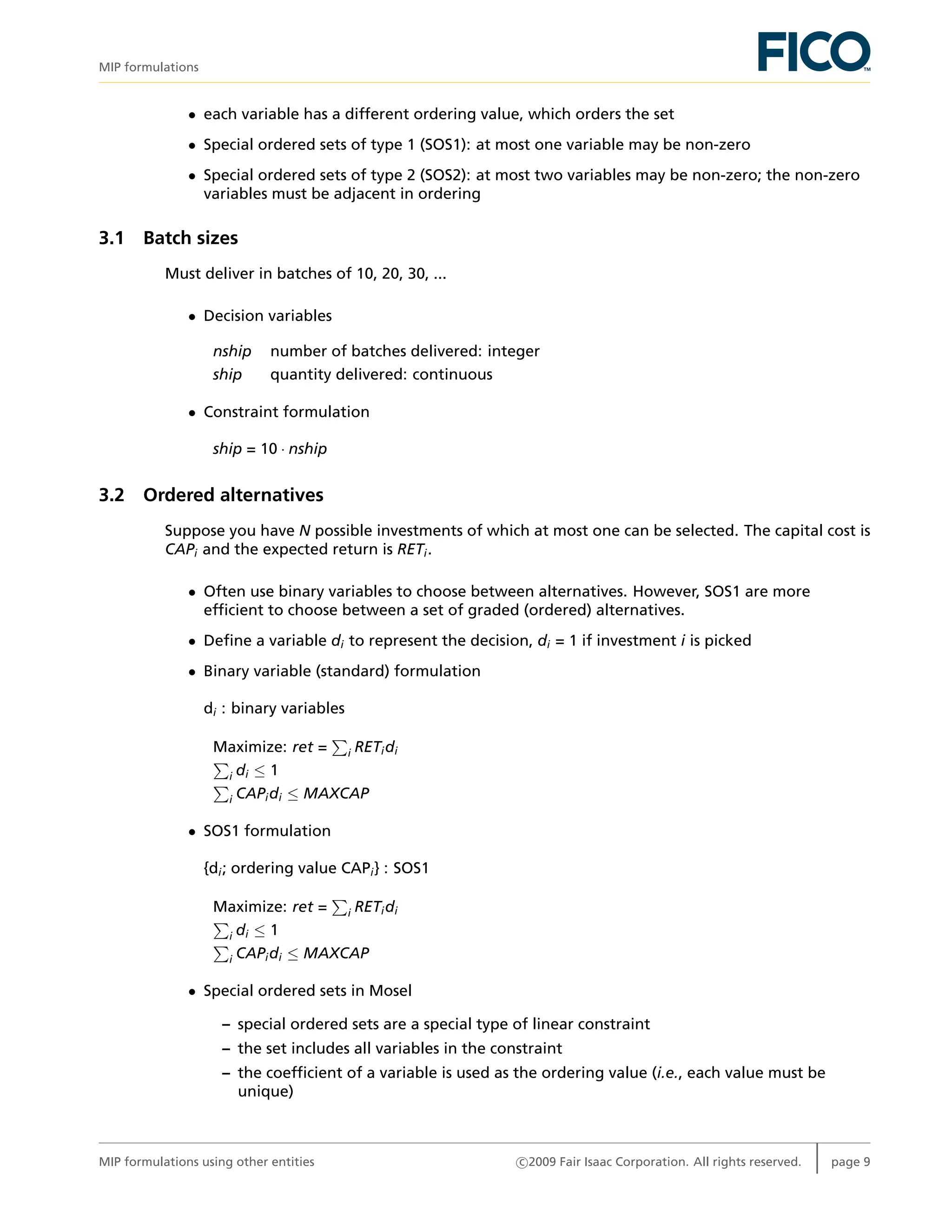
![MIP formulations
declarations
I=1..4
d: array(I) of mpvar
CAP: array(I) of real
My_Set, Ref_row: linctr
end-declarations
My_Set:= sum(i in I) CAP(i)*d(i) is_sos1
or alternatively (must be used if a coefficient is 0):
Ref_row:= sum(i in I) CAP(i)*d(i)
makesos1(My_Set, union(i in I) d(i), Ref_row)
• Special ordered sets in BCL
– a special ordered set is an object of type XPRBsos
– the set includes all variables from the specified linear expression or constraint that have
a coefficient different from 0
– the coefficient of a variable is used as the ordering value (i.e., each value must be
unique)
XPRBprob prob("testsos");
XPRBvar d[I];
XPRBexpr le;
XPRBsos My_Set;
double CAP[I];
int i;
for(i=0; i<I; i++) d[i] = prob.newVar("d");
for(i=0; i<I; i++) le += CAP[i]*d[i];
My_Set = prob.newSos("My_Set", XPRB_S1, le);
3.3 Price breaks
All items discount: when buying a certain number of items we get discounts on all items that we
buy if the quantity we buy lies in certain price bands.
Cost
xB1 B2 B3
COST1
COST2
COST3
less than B1 COST1 each
≥ B1 and < B2 COST2 each
≥ B2 and < B3 COST3 each
• Define binary variables bi (i=1,2,3), where bi is 1 if we pay a unit cost of COSTi.
• Real decision variables xi represent the number of items bought at price COSTi.
MIP formulations using other entities c 2009 Fair Isaac Corporation. All rights reserved. page 10](https://image.slidesharecdn.com/mipformulationsquickreference2-150926212704-lva1-app6892/75/Mip-formulations-quick_reference-2-12-2048.jpg)
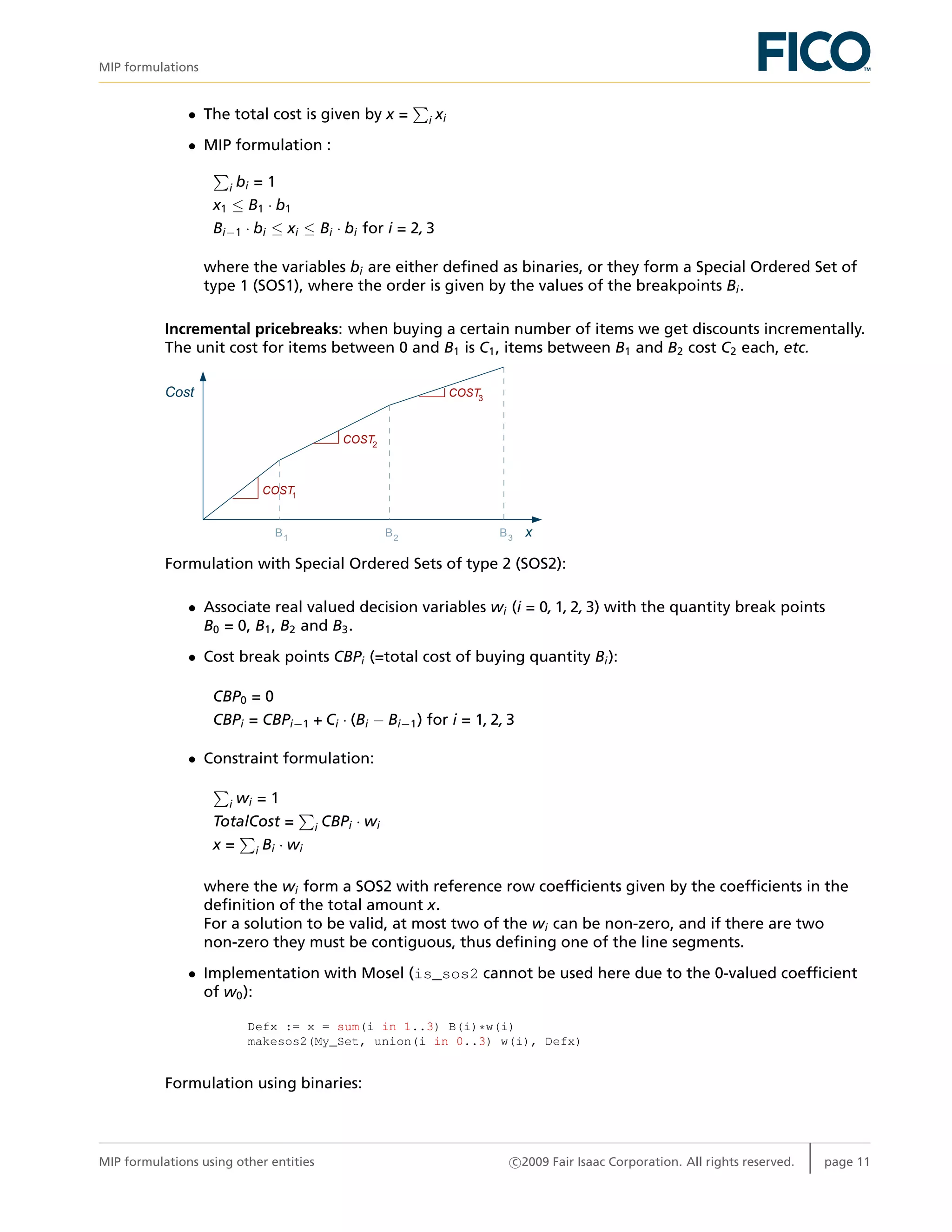
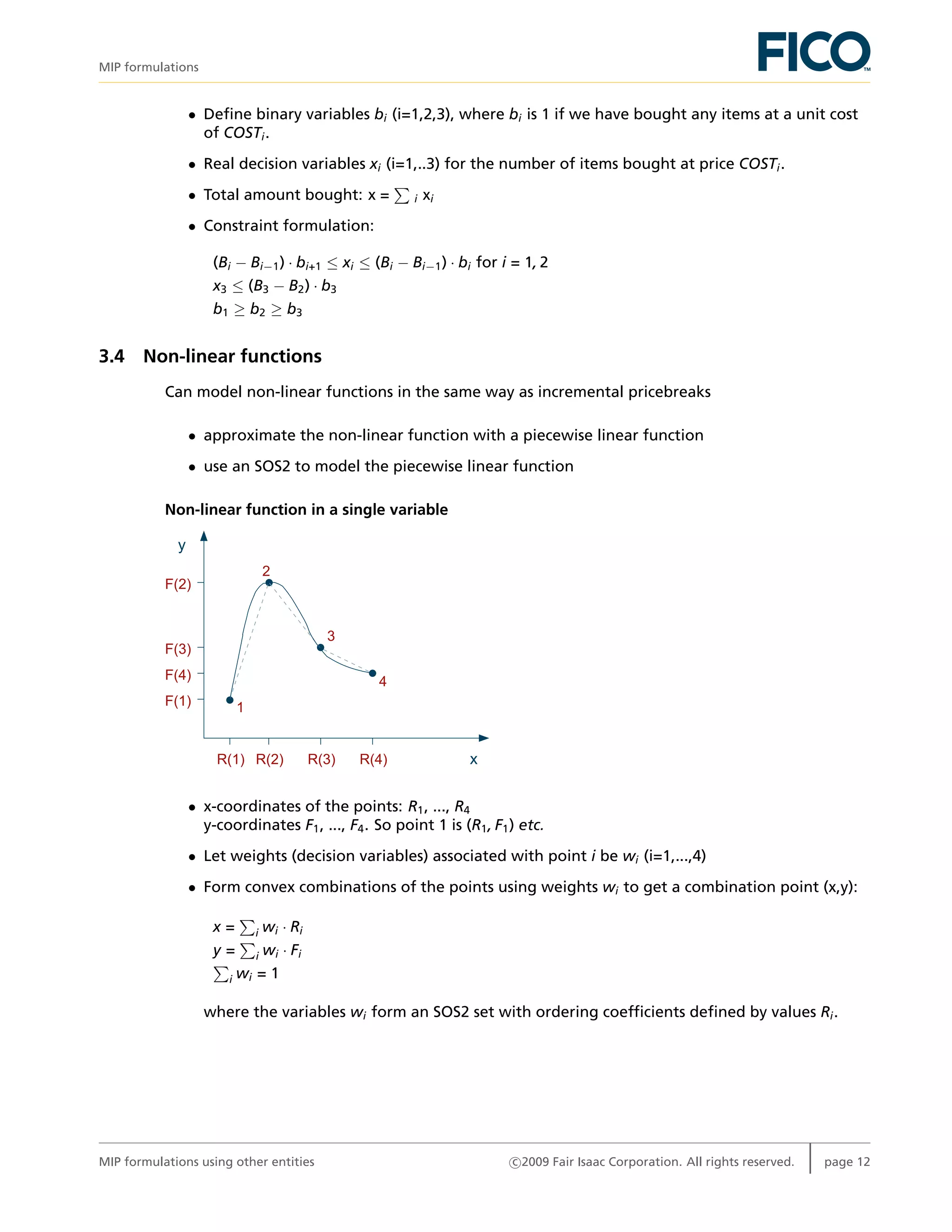
![MIP formulations
• Mosel implementation:
declarations
I=1..4
x,y: mpvar
w: array(I) of mpvar
R,F: array(I) of real
end-declarations
! ...assign values to arrays R and F...
! Define the SOS-2 with "reference row" coefficients from R
Defx:= sum(i in I) R(i)*w(i) is_sos2
sum(i in I) w(i) = 1
! The variable and the corresponding function value we want to approximate
x = Defx
y = sum(i in I) F(i)*w(i)
• BCL implementation:
XPRBprob prob("testsos");
XPRBvar x, y, w[I];
XPRBexpr Defx, le, ly;
double R[I], F[I];
int i;
// ...assign values to arrays R and F...
// Create the decision variables
x = prob.newVar("x"); y = prob.newVar("y");
for(i=0; i<I; i++) w[i] = prob.newVar("w");
// Define the SOS-2 with "reference row" coefficients from R
for(i=0; i<I; i++) Defx += R[i]*w[i];
prob.newSos("Defx", XPRB_S2, Defx);
for(i=0; i<I; i++) le += w[i];
prob.newCtr("One", le == 1);
// The variable and the corresponding function value we want to approximate
prob.newCtr("Eqx", x == Defx);
for(i=0; i<I; i++) ly += F[i]*w[i];
prob.newCtr("Eqy", y == ly);
Non-linear function in two variables
Interpolation of a function f in two variables: approximate f at a point P by the corners C of the
enclosing square of a rectangular grid (NB: the representation of P=(x,y) by the four points C
obviously means a fair amount of degeneracy).
P
C
C C
C
1 7 8 965432
1
2
4
5
6
3
MIP formulations using other entities c 2009 Fair Isaac Corporation. All rights reserved. page 13](https://image.slidesharecdn.com/mipformulationsquickreference2-150926212704-lva1-app6892/75/Mip-formulations-quick_reference-2-15-2048.jpg)
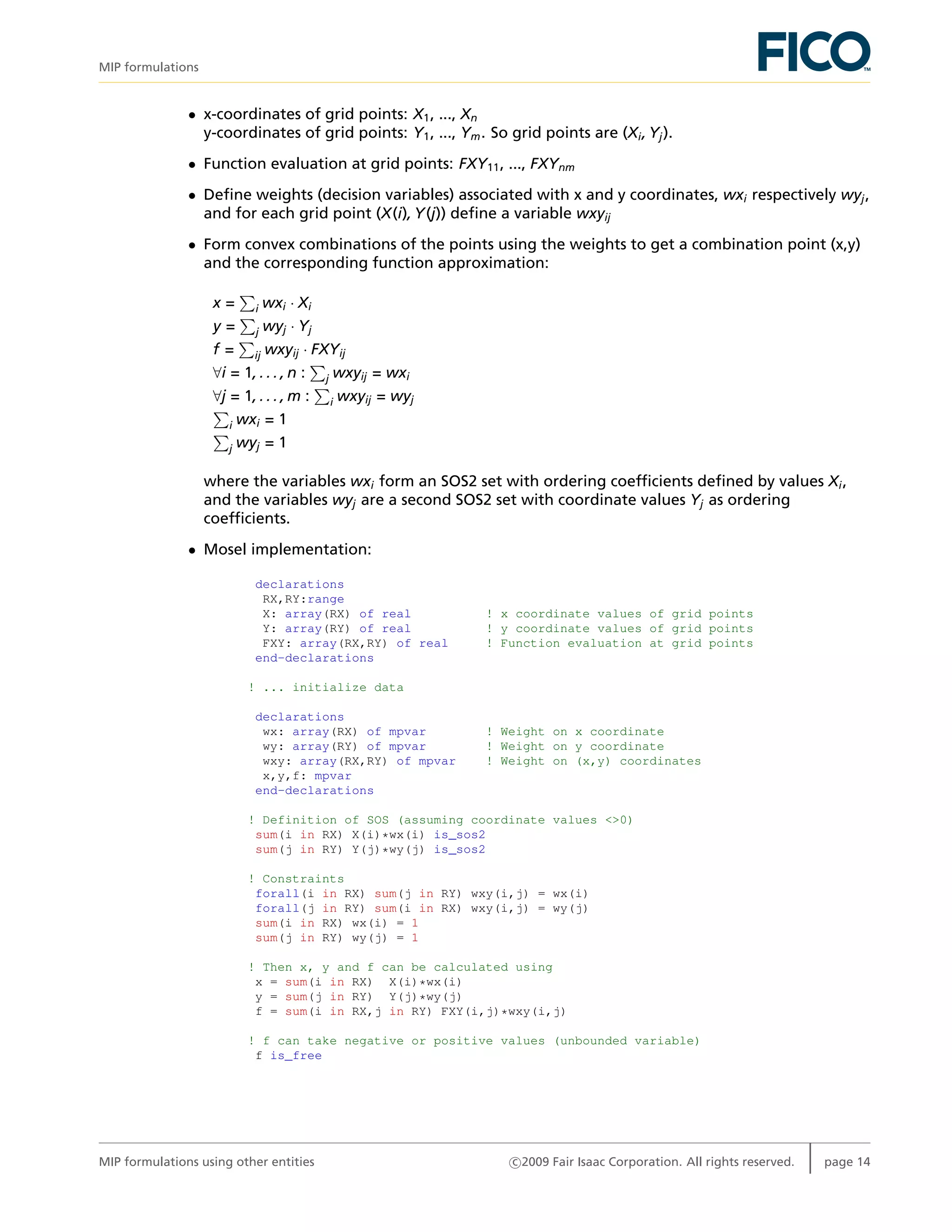
![MIP formulations
• BCL implementation:
XPRBprob prob("testsos");
XPRBvar x, y, f;
XPRBvar wx[NX], wy[NY], wxy[NX][NY]; // Weights on coordinates
XPRBexpr Defx, Defy, le, lexy, lx, ly;
double DX[NX], DY[NY];
double FXY[NX][NY];
int i,j;
// ... initialize data arrays DX, DY, FXY
// Create the decision variables
x = prob.newVar("x"); y = prob.newVar("y");
f = prob.newVar("f", XPRB_PL, -XPRB_INFINITY, XPRB_INFINITY); // Unbounded variable
for(i=0; i<NX; i++) wx[i] = prob.newVar("wx");
for(j=0; j<NY; j++) wy[j] = prob.newVar("wy");
for(i=0; i<NX; i++)
for(j=0; j<NY; j++) wxy[i][j] = prob.newVar("wxy");
// Definition of SOS
for(i=0; i<NX; i++) Defx += X[i]*wx[i];
prob.newSos("Defx", XPRB_S2, Defx);
for(j=0; j<NY; j++) Defy += Y[j]*wy[j];
prob.newSos("Defy", XPRB_S2, Defy);
// Constraints
for(i=0; i<NX; i++) {
le = 0;
for(j=0; j<NY; j++) le += wxy[i][j];
prob.newCtr("Sumx", le == wx[i]);
}
for(j=0; j<NY; j++) {
le = 0;
for(i=0; i<NX; i++) le += wxy[i][j];
prob.newCtr("Sumy", le == wy[j]);
}
for(i=0; i<NX; i++) lx += wx[i];
prob.newCtr("Convx", lx == 1);
for(j=0; j<NY; j++) ly += wy[j];
prob.newCtr("Convy", ly == 1);
// Calculate x, y and the corresponding function value f we want to approximate
prob.newCtr("Eqx", x == Defx);
prob.newCtr("Eqy", y == Defy);
for(i=0; i<NX; i++)
for(j=0; j<NY; j++) lexy += FXY[i][j]*wxy[i][j];
prob.newCtr("Eqy", f == lexy);
3.5 Minimum activity level
Continuous production rate make. May be 0 (the plant is not operating) or between allowed
production limits MAKEMIN and MAKEMAX
• Can impose using a semi-continuous variable: may be zero, or any value between the
intermediate bound and the upper bound
• Mosel:
make is_semcont MAKEMIN
make <= MAKEMAX
MIP formulations using other entities c 2009 Fair Isaac Corporation. All rights reserved. page 15](https://image.slidesharecdn.com/mipformulationsquickreference2-150926212704-lva1-app6892/75/Mip-formulations-quick_reference-2-17-2048.jpg)

![MIP formulations
uses "mmxprs"
declarations
R=1..10
C: array(range) of linctr
L: array(range) of logctr
x: array(R) of mpvar
b: array(R) of mpvar
end-declarations
forall(i in R) b(i) is_binary ! Variables for indicator constraints
C(2):= x(2)<=5
! Define 2 indicator constraints
L(1):= indicator(1, b(1), x(1)+x(2)>=12) ! b(1)=1 -> x(1)+x(2)>=12
indicator(-1, b(2), C(2)) ! b(2)=0 -> x(2)<=5
C(2):=0 ! Delete auxiliary constraint definition
Indicator constraints in BCL: an indicator constraint is defined by associating a binary decision
variable (XPRBvar) and an integer flag (1 for b → C and -1 for ¯b → C) with a linear inequality or
range constraint (XPRBctr). By defining an indicator constraint (function XPRBsetindicator or
method XPRBctr.setIndicator() depending on the host language) the type of the constraint
itself gets changed; it can be reset to ’standard constraint’ by calling the setIndicator function
with flag value 0.
XPRBprob prob("testind");
XPRBvar x[N], b[N];
XPRBctr IndCtr[N];
int i;
// Create the decision variables
for(i=0;i<N;i++) x[i] = prob.newVar("x", XPRB_PL); // Continuous variables
for(i=0;i<N;i++) b[i] = prob.newVar("b", XPRB_BV); // Indicator variables
// Define 2 linear inequality constraints
IndCtr[0] = prob.newCtr("L1", x[0]+x[1]>=12);
IndCtr[1] = prob.newCtr("L2", x[1]<=5);
// Turn the 2 constraints into indicator constraints
IndCtr[0].setIndicator(1, b[0]); // b(0)=1 -> x(0)+x(1)>=12
IndCtr[1].setIndicator(-1, b[1]); // b(1)=0 -> x(1)<=5
4.1 Inverse implication
b ← ax ≥ b
• Model as
¯b → ax ≤ b − m
where m is a sufficiently small value (slightly larger than the feasibility tolerance)
b ← ax ≤ b
• Model as
¯b → ax ≥ b + m
Indicator constraints c 2009 Fair Isaac Corporation. All rights reserved. page 17](https://image.slidesharecdn.com/mipformulationsquickreference2-150926212704-lva1-app6892/75/Mip-formulations-quick_reference-2-19-2048.jpg)
